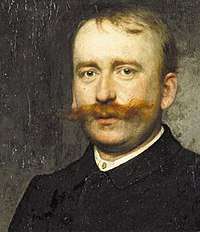Max Thedy
Max Thedy (16 October 1858, Munich - 13 August 1924, Polling[1]) was a German painter, designer and engraver. He is sometimes erroneously referred to as Marc Thedy.

Biography
He was the youngest of twelve children born to Johann Valentin Thedy, a Verwaltungsaktuar (administrative assistant in the community government) and his wife, Theresia.[1] After his parents' premature deaths, he was taken in by the family of the Hamburg painter, Georg Friedrich Louis Reinhardt (1819–1905) and encouraged to pursue a career in art.[2]
After 1875, he was a student at the Academy of Fine Arts, Munich. In 1882, aged only twenty-four, he was called to be a Professor at the Grand-Ducal Saxon Art School, Weimar. [1] Among his best known students were Elisabeth Thiermann, Christian Rohlfs, Ernest Biedermann and Rudolf Schmidt-Dethloff. In 1919, he became an instructor at the Bauhaus[1] and, in 1921, was named a Professor there.[1]
His works have been shown throughout Europe and the United States; most recently at exhibitions in Weimar (2002), Überlingen and Frankfurt am Main (2005).
References
- Peter Stapf: Der Maler Max Thedy (1858–1924). Leben und Werk. Böhlau, Cologne 2014.
- Max Thedy in the Matrikelbuch 1841–1884 of the Academy of Fine Arts, Munich.
Further reading
- Peter Stapf: Der Maler Max Thedy (1858–1924). Leben und Werk. Böhlau, Köln 2014, ISBN 978-3-412-22264-2. Substantial preview @ Google Books
- Siegfried Herrmann (Ed.): Max Thedy 1858–1924. Gemälde und Zeichnungen. Stadtmuseum, Weimar 2002, ISBN 3-910053-34-3 (Exhibition catalog) Stadtmuseum Weimar
- Volker Caesar: "Überlingens letzte Renaissancefenster als Motive der Malerei des späten 19. Jahrhunderts. Gemälde von Max Thedy dokumentieren seltene Fenster." In: Denkmalpflege in Baden-Württemberg, 36. 2007, pgs. 55–61 (Online)